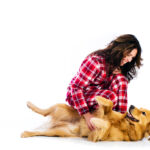How To Calm An Excited Dog
How to Calm an Excited Dog: A Comprehensive Guide
Dogs are known for their boundless energy and enthusiasm, but sometimes that energy can be a bit too much to handle. Whether it’s after a long walk, during playtime, or when meeting new people or animals, some dogs can become overly excited and difficult to calm down. If you’re struggling with an excitable pup, don’t worry – there are plenty of strategies you can use to help them settle down. In this article, we’ll explore some of the most effective ways to calm an excited dog.
Understanding the Causes of Excitement in Dogs
Before we dive into specific techniques for calming an excited dog, it’s important to understand what causes that excitement in the first place. There are a variety of factors that can contribute to a dog’s hyperactivity, including:
– Lack of exercise: Dogs need regular physical activity to burn off excess energy and maintain good health.
– Boredom: If your dog doesn’t have enough mental stimulation or opportunities for play and exploration, they may become restless and overexcited.
– Fear or anxiety: Some dogs become overly excited as a coping mechanism for underlying fears or anxieties. For example, a dog who is afraid of loud noises may become hyperactive when they hear thunder or fireworks.
– Overstimulation: Dogs who are exposed to too much excitement or stimuli at once (such as in a crowded park or busy household) may become overwhelmed and overexcited.
By understanding what triggers your dog’s excitement, you can begin to address those underlying issues and work towards a calmer, more relaxed pup.
Techniques for Calming an Excited Dog
1. Exercise Beforehand
One of the best ways to prevent your dog from becoming overly excited is to ensure they get plenty of exercise beforehand. A tired dog is less likely to be bouncing off the walls! Depending on your dog’s breed, age, and health needs, this may mean a long walk, a game of fetch, or some other form of physical activity. Be sure to consult with your veterinarian before starting any new exercise program.
2. Use Calming Signals
Dogs communicate through body language, so you can use calming signals to help your dog understand that it’s time to relax. Examples of calming signals include:
– Yawning
– Licking their lips
– Turning their head away from you
– Sitting or laying down
– Avoiding eye contact
By using these signals yourself (such as by yawning when your dog is overly excited), you can help your dog pick up on cues that it’s time to calm down.
3. Create a Quiet Space
If your dog becomes overstimulated easily, create a quiet space where they can retreat to when they need to unwind. This could be a cozy crate with comfortable bedding and a chew toy, or a designated area in your home where your dog knows they can go for some peace and quiet.
4. Practice Relaxation Techniques
Teaching your dog relaxation techniques can also be helpful for calming them down in the moment. For example, try teaching your dog to “settle” on command by having them lay down and relaxing their muscles. You can also try massages or aromatherapy (using essential oils such as lavender) to help soothe your pup.
5. Use Positive Reinforcement
Positive reinforcement is key when it comes to training your dog to calm down. Rewarding good behavior and ignoring bad behavior can help reinforce the message that being calm is desirable. Treats, praise, and playtime are all great ways to positively reinforce relaxed behavior.
6. Seek Professional Help
If your dog’s hyperactivity is causing significant problems (such as destructive behavior or aggression), it may be time to seek professional help from a certified animal behaviorist or trainer. These experts can help identify underlying issues and work with you to develop a personalized training plan.
In Conclusion
Calming an excited dog takes patience, understanding, and plenty of positive reinforcement. By addressing the underlying causes of your dog’s hyperactivity and using techniques such as exercise, calming signals, and relaxation techniques, you can help your pup become a more relaxed and contented companion. Remember to stay consistent in your training and seek professional help if needed – with time and effort, you can help your excitable dog learn to chill out!



